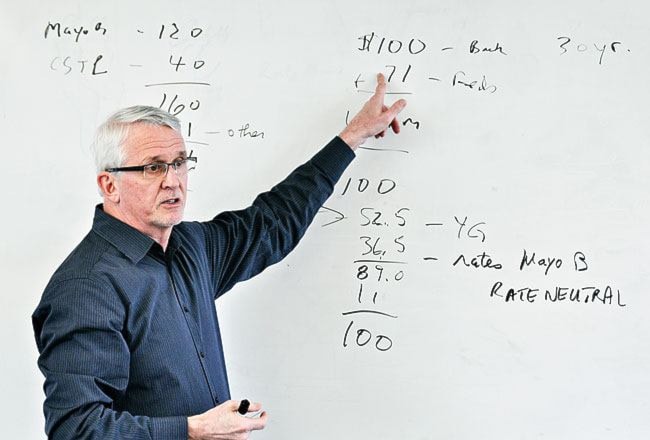The Yukon’s mineral rush could outpace electrical supply next year and wreak havoc on the Yukon Energy Corporation’s demand forecasts.
If Alexco’s Bellakeno mine and Wester Copper’s Carmacks mine go online as planned, Yukon Energy will have a shortage of cheap, low-emission hydro power, said president David Morrison on Monday.
“We would need additional hydro on the grid,” said Morrison, who was providing an update on the Mayo B dam expansion.
The Capstone Copper mine, online since 2007, is also planning to expand its operations in the near-term, according to news releases issued last month.
And even without the mines, commercial and residential demand would increase so quickly in the next five years that Mayo B won’t provide enough hydro power just three years after it is completed in December 2011, said Morrison.
“The one we’re more worried about is Western Copper, (we’re worried) if they’re moving forward or not, because that’s 50 gigawatt/hours,” said Morrison.
The unexpected bevy of quartz mines headed toward production will force Yukon Energy to use expensive diesel generators both before and after Mayo B is completed. It is difficult to predict the effect on the utility’s balance sheet because industrial customers increase revenue, while diesel fuel drives up the cost of production.
The anticipated demand is happening as the utility is building its most expensive project ever, the $120-million Mayo B.
Yukon Energy is also reeling from several controversies in 2009, including the mass resignation of half its board of directors. They quit after Premier Dennis Fentie tried to sell off the publicly owned corporation without telling the board, minister Jim Kenyon or the rest of his cabinet.
The utility has no candidates at the ready to replace the four board members. It will advertise for nominations to fill the board this week, said Morrison.
There has been no shortage of expertise at the executive level since the resignations, he said.
“The board gets the same exact reports and the same exact briefings.”
By Morrison’s own admission, this is one of the busiest agendas in Yukon Energy’s history.
And Mayo B is looking less like a silver bullet than a Band-Aid to the Yukon’s skyrocketing power demand.
The project will add two new turbines downstream from the existing Mayo power station in a new powerhouse. Yukon Energy recently issued tenders for turbine and generator procurement.
Groundwork has been done and preliminary construction will begin this summer.
The construction will be “rate-neutral” because the ratepayers’ bill, around $36 million, will be paid over the life of the project.
Another $53 million will be paid by Ottawa, while $36 million will be paid by the Yukon government through the Yukon Development Corporation.
Yukon Energy won’t have enough water to run both the old and the new powerhouse at full capacity year-round, said Morrison. When the water is high, the station will produce 15 megawatts, but production will never go below 10 megawatts, he said.
But both Alexco and Western Copper’s mine are slated to open before Mayo B is finished, between December 2011 and March 2012.
That means diesel generators will likely be used before and after Mayo B is in operation.
Alexco’s Bellekeno mine is hoping to begin production this summer.
The silver mine will use around 40 per cent of Mayo B’s power when the new powerhouse is finished.
Western Copper’s much larger project, slated to open in 2011 according to its website, will exceed Mayo B’s capacity to supply power, forcing Yukon Energy to fire up its diesels.
Currently, the Yukon can generate around 370 gigawatt/hours of power a year.
The Alexco and Western Copper mines will use another 64 gigawatt/hours a year when they’re online, forcing Yukon Energy to expand its capacity by roughly 25 per cent, to 434 gigawatt/hours.
Mayo B will only be able to provide 30 gigawatt/hours, which leaves the utility short 34 gigawatt/hours.
“We’re looking at new load in that range,” said Morrison.
The closest thing to completion is the Gladstone project, which is only in the “very early” stages of research, he said.
“We’re looking at Gladstone, we’re looking at Atlin, we’re looking at geothermal research to anticipate new load,” he said.
Yukon Energy has only done basic field studies for the Gladstone project, which would increase the water flowing through the Aishihik hydro station, said Morrison.
“We may have a wind turbine, we may have geothermal sources, we have four small hydro projects that were advancing, but it’s going to take a combination of things,” said Morrison.
Can any of these new sources come online soon enough for these mines?
“Pretty close,” said Morrison.
A study on the prospects of geothermal power from EBA Engineering will be shared with news outlets in the next few weeks, said Morrison.
Meanwhile, Yukon Energy’s board of directors will likely remain unfilled for a couple more months, he said.
Currently, the board is headed by interim chair, Pat Irvin, who runs a grocery store in Watson Lake.
The ads for nominations are being released nearly seven months after the resignations.
“We haven’t had ourselves organized to put them out earlier,” said Morrison.
Contact James Munson at
jamesm@yukon-news.com
